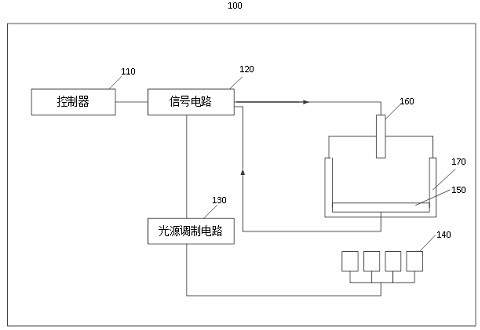Carbohydrate lactic acid bacteria metabolism analysis and detection device and method
A detection device and a technology for lactic acid bacteria, applied in the field of biosensors, can solve problems such as poor subjectivity and accuracy, and achieve the effects of reducing signal drift and reducing costs
- Summary
- Abstract
- Description
- Claims
- Application Information
AI Technical Summary
Problems solved by technology
Method used
Image
Examples
Embodiment 1
[0025] Such as figure 1 As shown, the carbohydrate lactic acid bacteria metabolism analysis and detection device 100 provided by the present invention includes: a controller 110, a signal circuit 120, a light source modulation circuit 130, an excitation light source 140, an optical addressable potential sensor 150, a reference electrode 160, and a test chamber 170. The test cavity 170 is fixed on the front of the optical addressable potential sensor 150 , and the reference electrode 160 is inserted into the top cover of the test cavity 170 to apply a bias voltage to the optical addressable potential sensor 150 . The optical addressable potential sensor 150 is packaged on the PCB through pads, and connected to the signal circuit 120 for signal collection. The PCB board packaged with the optical addressable potential sensor 150 is fixed to the bottom of the test cavity 170 for detection. The excitation light source 140 is arranged on the back of the optical addressable potentia...
Embodiment 2
[0042] The catabolism of sugar by lactic acid bacteria mainly includes two pathways, namely, the glycolysis pathway (homolactic fermentation) and the phosphoketolase pathway (heterolactic fermentation). The glycolytic pathway (embden-meverhef-parnus pathway, EMP) refers to the fermentation of glucose to lactic acid and adenosine triphosphate (ATP) under anaerobic conditions. The phosphoketolase pathway (PK) refers to the glycolysis of glucose to produce equal amounts of lactic acid, ethanol, and CO under anaerobic conditions. 2 and ATP. Therefore, lactic acid bacteria will produce lactic acid that affects the taste when metabolizing sugar. The sugar lactic acid bacteria metabolism analysis and detection device provided by the present invention is used to monitor the catabolism of lactic acid bacteria to different sugars by detecting changes in pH. Such as Figure 4 As shown, the carbohydrate lactic acid bacteria metabolic analysis detection method of the present invention i...
PUM
| Property | Measurement | Unit |
|---|---|---|
| Thickness | aaaaa | aaaaa |
Abstract
Description
Claims
Application Information
 Login to View More
Login to View More - R&D
- Intellectual Property
- Life Sciences
- Materials
- Tech Scout
- Unparalleled Data Quality
- Higher Quality Content
- 60% Fewer Hallucinations
Browse by: Latest US Patents, China's latest patents, Technical Efficacy Thesaurus, Application Domain, Technology Topic, Popular Technical Reports.
© 2025 PatSnap. All rights reserved.Legal|Privacy policy|Modern Slavery Act Transparency Statement|Sitemap|About US| Contact US: help@patsnap.com



